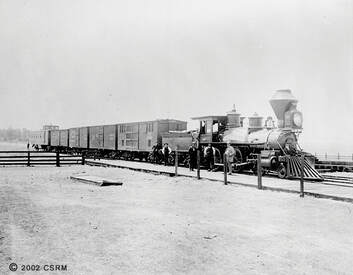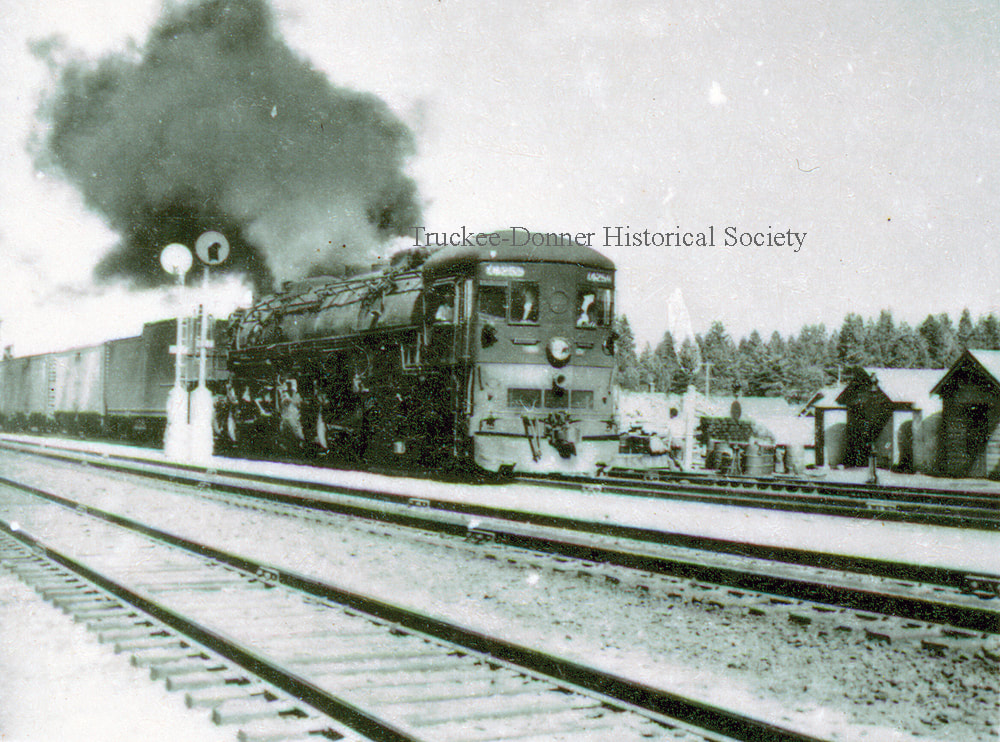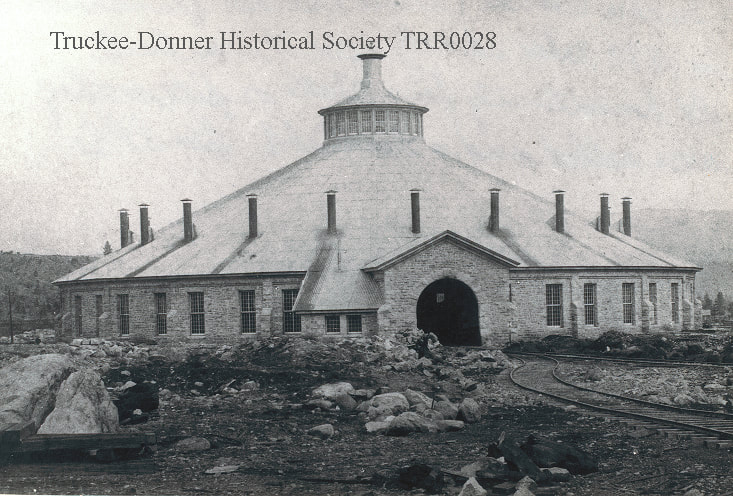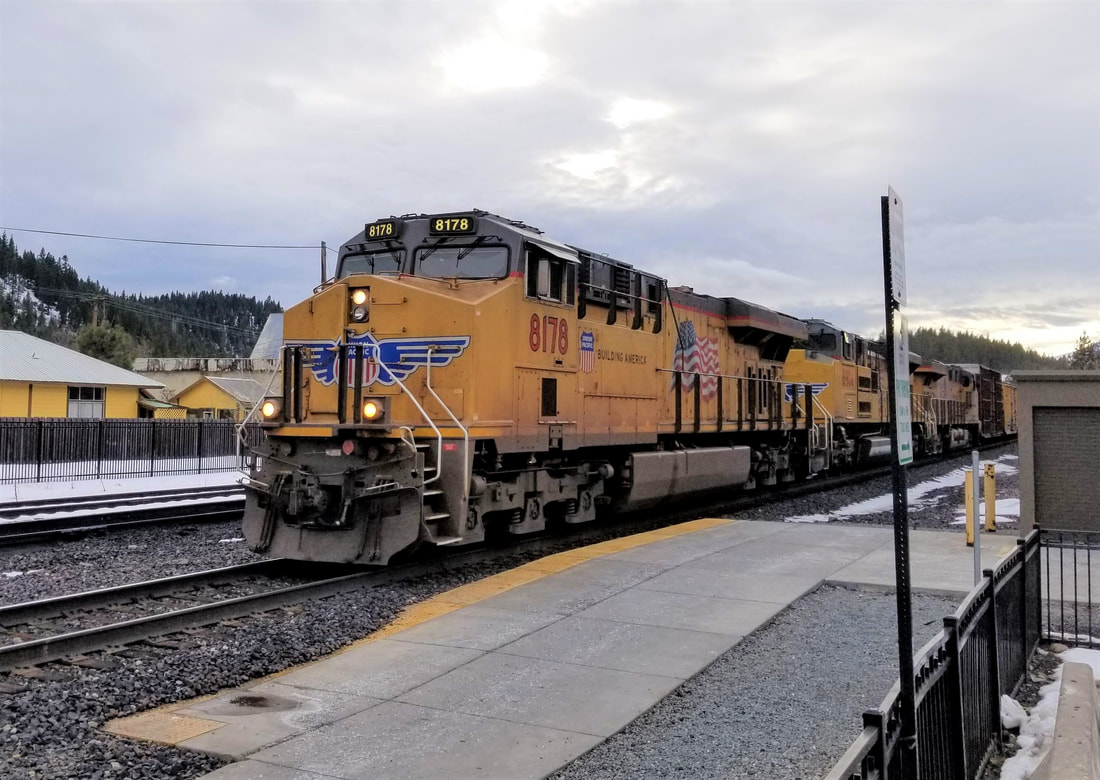150 Years of Truckee Railroading
By Daniel Cobb*
Truckee has been a railroad town ever since Theodore Judah’s Donner Pass Route was chosen for the first Transcontinental Railroad in 1862. The new Museum of Truckee History, scheduled to open this summer in the downtown train depot building, will highlight the town’s railroad history with interactive displays, models, and artifacts in an exhibit called “Railroading, Then and Now”.
Early Train Travel on the Transcontinental
Passenger and freight service through Truckee began as soon as the Central Pacific tracks reached town in 1867. Once the Central Pacific and Union Pacific met at Promontory Point to complete the Transcontinental Railroad in 1869, a trip from Chicago to San Francisco that had taken 7 months by wagon could be completed in 7 days by rail. Train travel on the Transcontinental was not easy, however. If you had been a passenger on one of those trains, it’s likely you would have travelled on a one-way ticket in an “emigrant car”. Those coaches offered little in the way of creature comforts; they provided cheap basic transportation for adventurers seeking to make a new life in California. Passengers endured constant jostling, hard seats, poor ventilation, heat, cold, and close contact with fellow passengers who had likely not bathed for days. They ate whatever food they had brought with them, or could purchase at the desolate outposts where the train stopped for water and fuel.
Early freight trains westbound through Truckee carried mainly manufactured goods and emigrants’ personal property from the east. Trains from California carried agricultural products, lumber, and other raw materials from California.
A Railroad Hub in the early 1900s
Two or three decades later, train travel was reliable and relatively comfortable. While there were multiple classes of service, you could have travelled in style in a Pullman Palace car, complete with mechanical ventilation, sleeping “berths” that pulled down from above your seat, curtains for privacy, and on-board dining. Passenger train traffic hit its peak in 1913 with 18 regularly scheduled passenger trains through Truckee every day.
In the early 1900s, Truckee was a center of railroad activity. In addition to the Transcontinental, Truckee was a hub for the lumber industry, with logs and hewn lumber rolling into town from Hobart Mills and other points north and from Squaw Valley and Ward Creek to the south. The tourist industry was beginning at Lake Tahoe, and travelers transferred at Truckee to the narrow-gauge Lake Tahoe Railway & Transportation Company railroad for the trip up the Truckee River to Tahoe City. Powerful steam “helper” engines were stabled in the huge granite roundhouse east of town, ready to help push heavy trains over Donner Summit.
Streamliners and Ice Reefers
The mid-1930s saw the inauguration of sleek passenger streamliners, including fast luxury trains such as the Overland, the Forty-Niner, and the diesel-powered City of San Francisco, which shortened the trip from San Francisco to Chicago to just 40 hours. Among the premium services provided on the City were stewardess-nurses, a barber shop, a shower bath, and an internal telephone system.
Perhaps the greatest advance of the 20th century in railroad shipping was the use of refrigeration to ship California citrus and other produce across the country. The first refrigerator cars (“reefers”) used ice for cooling and sawdust for insulation. Much of the ice was harvested from lakes and dammed streams around Truckee. By the 1930s, 80-car eastbound “reefer blocks” were a common sight in Truckee, often headed by an enormous cab forward “mallet” steam engine with 16 drive wheels and weighing over 300 tons. These refrigerated trains fueled the growth of the California citrus and produce industry by opening up markets beyond the then sparsely-populated West Coast.
Truckee Railroading Today
Truckee’s importance as a railroad hub has, of course, declined over the decades. Railroad logging came to an end as trucks took over and the first growth forests were exhausted. Autos replaced trains for most tourist travel with the development of more reliable cars and the interstate. Long-distance passenger service was consolidated under the management of Amtrak in 1971. The helper engines that once pushed trains over Donner are now housed “down the hill” in Sparks.
Despite the decline in activity, the railroad remains a visible and important part of Truckee’s fabric. 15,000 passengers embark or debark the Amtrak at Truckee each year, and many more pass through on their way to the Midwest or the California coast. Ten to twenty long freight trains pass through daily, carrying agricultural products from the Midwest and intermodal container trains from California ports. Truckee’s maintenance shop is often used to service and ‘maintenance of way’ (right of way) railroad and snow fighting equipment, as it did last year when one of UP’s rotary snowplows broke down near the summit.
Museum of Truckee History
The new museum will have photographs, artifacts, and models illustrating the rich history of Truckee railroading. Stop by and see how Truckee railroading has changed – and how railroading has changed Truckee!
About the Author:
Daniel Cobb is a railroad modeler, amateur historian, and volunteer with the Truckee Donner Railroad Society. He lives in Tahoe Vista.
(c) Truckee-Donner Historical Society 2020
Uploaded 2/11/2021 HCS
Early Train Travel on the Transcontinental
Passenger and freight service through Truckee began as soon as the Central Pacific tracks reached town in 1867. Once the Central Pacific and Union Pacific met at Promontory Point to complete the Transcontinental Railroad in 1869, a trip from Chicago to San Francisco that had taken 7 months by wagon could be completed in 7 days by rail. Train travel on the Transcontinental was not easy, however. If you had been a passenger on one of those trains, it’s likely you would have travelled on a one-way ticket in an “emigrant car”. Those coaches offered little in the way of creature comforts; they provided cheap basic transportation for adventurers seeking to make a new life in California. Passengers endured constant jostling, hard seats, poor ventilation, heat, cold, and close contact with fellow passengers who had likely not bathed for days. They ate whatever food they had brought with them, or could purchase at the desolate outposts where the train stopped for water and fuel.
Early freight trains westbound through Truckee carried mainly manufactured goods and emigrants’ personal property from the east. Trains from California carried agricultural products, lumber, and other raw materials from California.
A Railroad Hub in the early 1900s
Two or three decades later, train travel was reliable and relatively comfortable. While there were multiple classes of service, you could have travelled in style in a Pullman Palace car, complete with mechanical ventilation, sleeping “berths” that pulled down from above your seat, curtains for privacy, and on-board dining. Passenger train traffic hit its peak in 1913 with 18 regularly scheduled passenger trains through Truckee every day.
In the early 1900s, Truckee was a center of railroad activity. In addition to the Transcontinental, Truckee was a hub for the lumber industry, with logs and hewn lumber rolling into town from Hobart Mills and other points north and from Squaw Valley and Ward Creek to the south. The tourist industry was beginning at Lake Tahoe, and travelers transferred at Truckee to the narrow-gauge Lake Tahoe Railway & Transportation Company railroad for the trip up the Truckee River to Tahoe City. Powerful steam “helper” engines were stabled in the huge granite roundhouse east of town, ready to help push heavy trains over Donner Summit.
Streamliners and Ice Reefers
The mid-1930s saw the inauguration of sleek passenger streamliners, including fast luxury trains such as the Overland, the Forty-Niner, and the diesel-powered City of San Francisco, which shortened the trip from San Francisco to Chicago to just 40 hours. Among the premium services provided on the City were stewardess-nurses, a barber shop, a shower bath, and an internal telephone system.
Perhaps the greatest advance of the 20th century in railroad shipping was the use of refrigeration to ship California citrus and other produce across the country. The first refrigerator cars (“reefers”) used ice for cooling and sawdust for insulation. Much of the ice was harvested from lakes and dammed streams around Truckee. By the 1930s, 80-car eastbound “reefer blocks” were a common sight in Truckee, often headed by an enormous cab forward “mallet” steam engine with 16 drive wheels and weighing over 300 tons. These refrigerated trains fueled the growth of the California citrus and produce industry by opening up markets beyond the then sparsely-populated West Coast.
Truckee Railroading Today
Truckee’s importance as a railroad hub has, of course, declined over the decades. Railroad logging came to an end as trucks took over and the first growth forests were exhausted. Autos replaced trains for most tourist travel with the development of more reliable cars and the interstate. Long-distance passenger service was consolidated under the management of Amtrak in 1971. The helper engines that once pushed trains over Donner are now housed “down the hill” in Sparks.
Despite the decline in activity, the railroad remains a visible and important part of Truckee’s fabric. 15,000 passengers embark or debark the Amtrak at Truckee each year, and many more pass through on their way to the Midwest or the California coast. Ten to twenty long freight trains pass through daily, carrying agricultural products from the Midwest and intermodal container trains from California ports. Truckee’s maintenance shop is often used to service and ‘maintenance of way’ (right of way) railroad and snow fighting equipment, as it did last year when one of UP’s rotary snowplows broke down near the summit.
Museum of Truckee History
The new museum will have photographs, artifacts, and models illustrating the rich history of Truckee railroading. Stop by and see how Truckee railroading has changed – and how railroading has changed Truckee!
About the Author:
Daniel Cobb is a railroad modeler, amateur historian, and volunteer with the Truckee Donner Railroad Society. He lives in Tahoe Vista.
(c) Truckee-Donner Historical Society 2020
Uploaded 2/11/2021 HCS




